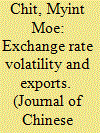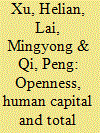| Srl | Item |
| 1 |
ID:
082899


|
|
|
|
|
| Publication |
2008.
|
| Summary/Abstract |
This paper studies the internationalisation of Chinese piano firms from a branding perspective. The purpose of the paper is twofold. First, it examines the interplay between the country of origin (COO) effect and international branding, and how COO affects the choice of branding strategies in international markets. Second, it explores the possible link between international branding decisions and international expansion of the firm. A model is introduced that illustrates the relationships between COO, branding options and internationalisation. Corresponding to its progress in internationalisation, a firm's branding development in international markets may follow certain stages. As the firm moves to advanced stages, it increases its international brand equity; the impact from negative COO will decrease and eventually become irrelevant. The literature on internationalisation is largely based on the experience of MNEs from Western developed countries. Multinational firms from developing countries such as China possess some unique characteristics that make it very difficult to apply Western theories to them. The emergence of MNEs from developing countries calls for the development of new theories.
|
|
|
|
|
|
|
|
|
|
|
|
|
|
|
|
| 2 |
ID:
082894


|
|
|
|
|
| Publication |
2008.
|
| Summary/Abstract |
This paper evaluates the usefulness of business sentiment indicators for forecasting developments in the Chinese real economy. We use data on diffusion indices collected by the People's Bank of China for forecasting industrial production, retail sales and exports. Our bivariate vector autoregressive models, each composed of one diffusion index and one real sector variable, generally outperform univariate autoregressive models in forecasting one to four quarters ahead. Similarly, principal components analysis, combining information from various diffusion indices, leads to enhanced forecasting performance. Our results indicate that Chinese business sentiment indicators convey useful information about current and future developments in the real economy. Moreover, the results could be seen as support for the reliability of the official data on the real economy, as both survey and real sector data seem to reflect the same underlying economic dynamics.
|
|
|
|
|
|
|
|
|
|
|
|
|
|
|
|
| 3 |
ID:
082896


|
|
|
|
|
| Publication |
2008.
|
| Summary/Abstract |
This paper examines the impact of exchange rate volatility on the bilateral exports within the ASEAN-China Free Trade Area (ACFTA) by using a generalized gravity model. A panel data set of 20 bilateral observations for the period from 1982:Q1 to 2005:Q1 is estimated using fixed-effect and random effect methods. Panel unit-roots and panel cointegration tests confirm the long-run relationship among the variables. The empirical results suggest that bilateral real exchange rate volatility has a statistically significant negative impact on the bilateral exports of the major ACFTA countries. But the magnitude of the impact appears to be fairly small
|
|
|
|
|
|
|
|
|
|
|
|
|
|
|
|
| 4 |
ID:
082900


|
|
|
|
|
| Publication |
2008.
|
| Summary/Abstract |
Trust is important in that it facilitates relational exchanges by permitting partners to transcend short-run inequities or risks to concentrate on long-term profits or gains. This study investigates what factors affect the trust between distribution-channel members, principally those between Korean IT firms and their exporting partners in China. We suggest that factors affecting trust include reputation, size, expertise, length of the relationship, communication, and satisfaction with previous outcomes of conflict episodes. Data were collected through a survey of 128 Korean IT firms, which have export-transaction relationships with Chinese buyers. The data strongly support the research hypotheses. As hypothesized, the results of data analysis show that reputation, communication, and satisfaction with previous outcomes tend to enhance trust. Additionally, we noticed that trust seems to decrease as the experience of conflict episodes increases
|
|
|
|
|
|
|
|
|
|
|
|
|
|
|
|
| 5 |
ID:
082898


|
|
|
|
|
| Publication |
2008.
|
| Summary/Abstract |
It is widely recognized that location is the primary determining factor of housing price. But to what extent the variation of housing price in Shanghai can be explained by the locational factor has not been empirically examined. In this paper, we examine the power of applying the hedonic method to the spatial-statistical analysis of housing prices in Shanghai. The data we use covers all new commercial residential housings sold in Shanghai during July 2004 and June 2006. The main focus in this paper is to examine the effect of geographical distance to city centre on the selling price of residential housings in Shanghai. We also discuss how the price gradient varies at different directions in Shanghai. Finally, we demonstrate the importance of applying quality control on the development of a housing price index. The statistical methodology and empirical results obtained in this paper carry interesting implications for other cities in China as well.
|
|
|
|
|
|
|
|
|
|
|
|
|
|
|
|
| 6 |
ID:
082897


|
|
|
|
|
| Publication |
2008.
|
| Summary/Abstract |
This paper examines the drivers behind China's economic growth. In particular, it focuses on the channels of knowledge spillovers: human capital and openness to trade and foreign direct investment. The specific features of the study include using the most recent comprehensive panel data consisting of 29 provinces during the period 1994-2006 and performing unit root and cointegration tests in the panel data framework. The paper finds that human capital, trade and FDI are the significant determinants of total factor productivity, but their importance varies with technological levels of provinces. These findings have important policy implications.
|
|
|
|
|
|
|
|
|
|
|
|
|
|
|
|
| 7 |
ID:
082895


|
|
|
|
|
| Publication |
2008.
|
| Summary/Abstract |
A bilateral export demand function is used to estimate the effects on the Chinese bilateral exports of three real exchange rates: (1) bilateral real exchange rate capturing the price-competitiveness of the Chinese products in the market of the considered import country (traditional effect); (2) real effective exchange rate capturing the price-competitiveness of the goods of Chinese competitors in the same market (third-export-country effect); (3) real effective exchange rate capturing the price-competitiveness of the Chinese products in China's other export markets (third-import-country effect). This function is applied for the Chinese bilateral real exports towards 11 industrialized countries over the period from 1991 to 2004. The econometric results confirm the effects of the three real exchange rates, as well as the effects of the demand from developed countries.
|
|
|
|
|
|
|
|
|
|
|
|
|
|
|
|